
One thing is a certainty when speaking about internet behavior. That is, people will get butt-hurt about how other individuals train. Some arguments get the internet warriors more emotional than others. Talking about Raw vs Gear, Carbs, CrossFit, and recently... Agility ladders. People insist on taking a side on these issues and the use of agility ladders are no different. Like any topic of debate, it usually comes down to context.
This video has been floating around Social Media and basically replicates what "Agility Ladder Footwork" would look like on the field.
How football would look if "agility" ladder drills actually applied to a game situation. pic.twitter.com/c78ooBnmQE
— Joseph Potts (@TopSpeedLLC) May 13, 2015
My Take
To be honest, I am not a huge fan of the implement, but I have used them as a coach. I can see why other coaches use them and conversely, why some coaches avoid them like the plague. Here's some quick True-False statements on what I believe. For the sake of this article, lets use the title agility-ladder and speed-ladder interchangeably.
Agility Ladders are an adequate warm-up variation. TRUE
Athletes can become very complacent and variety is your friend as a coach. Incorporating agility ladder drills can prepare
Parents love Agility Ladders. TRUE
Parents love seeing their 8-10 year-olds do rehearsed patterns through these ladders. Again, for the younger athlete, providing them with drills where they can reinforce body-awareness and require them to move their feet fast is not going to hinder their physical development. There are developmental windows that would make programming these types of drills beneficial.
Using Agility Ladders will improve my foot-speed on the field or court. FALSE
Whatever pattern you have had your athletes memorize and perform, please note that these are specific to the learned and rehearsed movement. The skill acquisition is specific to that pattern. To say there is carryover to having "quick feet" on the field or court is naive.
Athletes running through every pattern imaginable thorough the ladders are moving their feet as fast as they can without covering any ground. Working on how fast they can put one foot down next to the other and not understanding why this isn't equating to an explosive "first step". We see people every day that take a lot of small steps and give the impression they are athletically gifted. The problem is how much ground is covered on each step is minimal
Agility Ladders will improve my ability to change directions: FALSE
Well, not entirely false. But, it is impossible to replicate the ground forces and joint angles that an athlete would need to endure playing at full speed with a ladder drill. The biomechanical positioning and force require to reduce the amortization phase does not equate when performing drills in a ladder.
With that being said, there are a few drills that can help athletes with some mental and physical cues to achieve similar positions. These may be excellent drills to incorporate into the warm-up while still predisposing athletes to the basic mechanics of each particular cut.
Two Lateral Speed Drills
Here are two drills that can actually benefit athletes in simulating basic change of direction body positions.
In this video, Verlon Reed (Detroit Lions), Ryland Ward, (BGSU Alumn), and Roosevelt Nix (Pittsburgh Steelers) go through two drills on the ladder. Notice that with 3 different athletes playing 3 different positions, these reps will all vary in execution.
1. Icky Shuffle - Power Cuts
The Key is to emphasize pushing off the outside foot and keep the COG over the inside foot
2. Cross Overs -Speed Cuts or Lateral Starts
This will reinforce driving the opposite knee while keeping weight on the outside foot to change directions.
The key with both drills is body positioning, a low center-of-gravity, and executing the proper footwork.
Linear Speed
One drill that can be successful in the development of linear speed are single leg sprints or bounds. These drills can be done without a ladder, but the ladder provides a built-in sequenced progression.
This is not for beginners or to be implemented early in the training cycle as there is a bit of a learning curve for any non-track athlete. This drill can have a significant carry-over in sprint speed due to the accentuated ground contact force and the biomotor similarities in the drills at certain stride lengths for the single leg drills. Here is the progression. Note: Not all athletes will progress to the fourth progression. The third progression may serve as single-leg bounds depending on the training age and athletic ability.
- Single Leg Hops - Every hole (not shown)
- Single Leg Runs - Skip One Hold
- Single Leg Sprints - Skip Two holes
- Single Leg "Bounds" - Skip Three Holes (not shown)
A few tips on improving technique with this drill would be to ensure proficiency in some prerequisite drills including:
- Single leg broad jumps
- Single leg box jumps
- Alternating leg bounds
Coaching tips
- Have the athlete job up to the start of the ladder or line to gain forward momentum to execute the movement
- Ensure the athlete sprints after completing the ladder
This is not to say these drills, if incorporated into your training program will significantly enhance speed and agility. This is just to say that agility ladders can have some merit in any training program.









